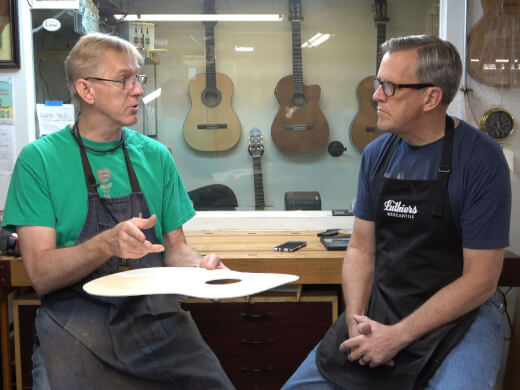About This Course
Welcome to the Robert O’Brien Online 6 Day Acoustic Guitar Building Course. In this course Robert, not only shows how he has updated and adapted his guitar building methods over the years but he also stresses the importance of working efficiently while building. In his original Classical guitar building course he teaches how to build and finish a guitar organizing each topic by chapter and lesson. For example: Chapter 1 - The neck, Chapter 2 – The sides etc. In this new 6 Day course he has it organized by days and all the steps accomplished on those days, culminating in a completely finished and playable guitar by the morning of Day 6. This means he may start by thicknessing and bending a side, then jump to joining the top and back, doing a scarf joint, making blocks, bending the second side etc. and all of this before lunch of Day one!
He also does that in the presence of students. This allows the viewer to see and hear Robert address questions and issues that may not arise in a regular style instructional video course with just the instructor teaching. The interaction between Robert and his students allows the viewer to see steps done by Robert as well as his students while he is teaching. Watch as he adapts his teaching style to meet the necessities of each student and their abilities, helping them become efficient in each step of the guitar building process. This is much more than a how to build a guitar course. If you want just that, I recommend getting my original Online Classical Guitar Building course. Now, if you want to learn more tips and tricks on building and my most up to date techniques, yes, I have changed my methods somewhat since the original course, as well as how to work efficiently, then this course is for you.
Learn about shop layout and workflow and how that can shave hours and even days off the time needed to build a guitar. Learn how few tools and jigs Robert actually uses while building.
When you purchase the course you also become eligible to join Robert’s invitation only private chat group. Here he offers advice and support as you build. There is a wealth of information available to you for free and over 15 years worth of searchable archives!
If you have ever wanted to learn how to build your own high end classical guitar and do it efficiently using Robert’s most up to date techniques, then Robert’s Online 6 Day Classical Guitar Building Course is a must! It also includes a free tool list! Just click on the link below to download.
Please read the FAQ page before beginning. To begin, just register/login and purchase the video lessons.
It has never been easier to learn the art of guitar building.
Happy Building!
Students who have taken Robert O’Brien’s in-house 6-day classical guitar building course are eligible for a 25% off discount. Please contact us to claim this offer.
So far, I'm loving this course! 1) Quality of the video - HD 2) Very Very natural presentation 3) Great clarification on things that aren't so obvious for a first timer, (ex. why the peg head angles differ due to the type of tuners). 4) My favorite so far are the signs by the jointer "If Dad can't fix it, We're Screwed." Hilarious 😂 Rolando
Feedback
×The course is 100% worthwhile, and allows all levels of student expertise to take part in / witness a great guitar building process. Pat
Your descriptions and video are clear and concise. This new video series should be perfect for students coming to your shop to build an instrument. I like your stress on efficiency. It’s not just about the ability to work professionally, but also satisfaction with the process and safety. Peter
So far, I'm loving this course! 1) Quality of the video - HD 2) Very Very natural presentation 3) Great clarification on things that aren't so obvious for a first timer, (ex. why the peg head angles differ due to the type of tuners). 4) My favorite so far are the signs by the jointer "If Dad can't fix it, We're Screwed." Hilarious 😂 Rolando





